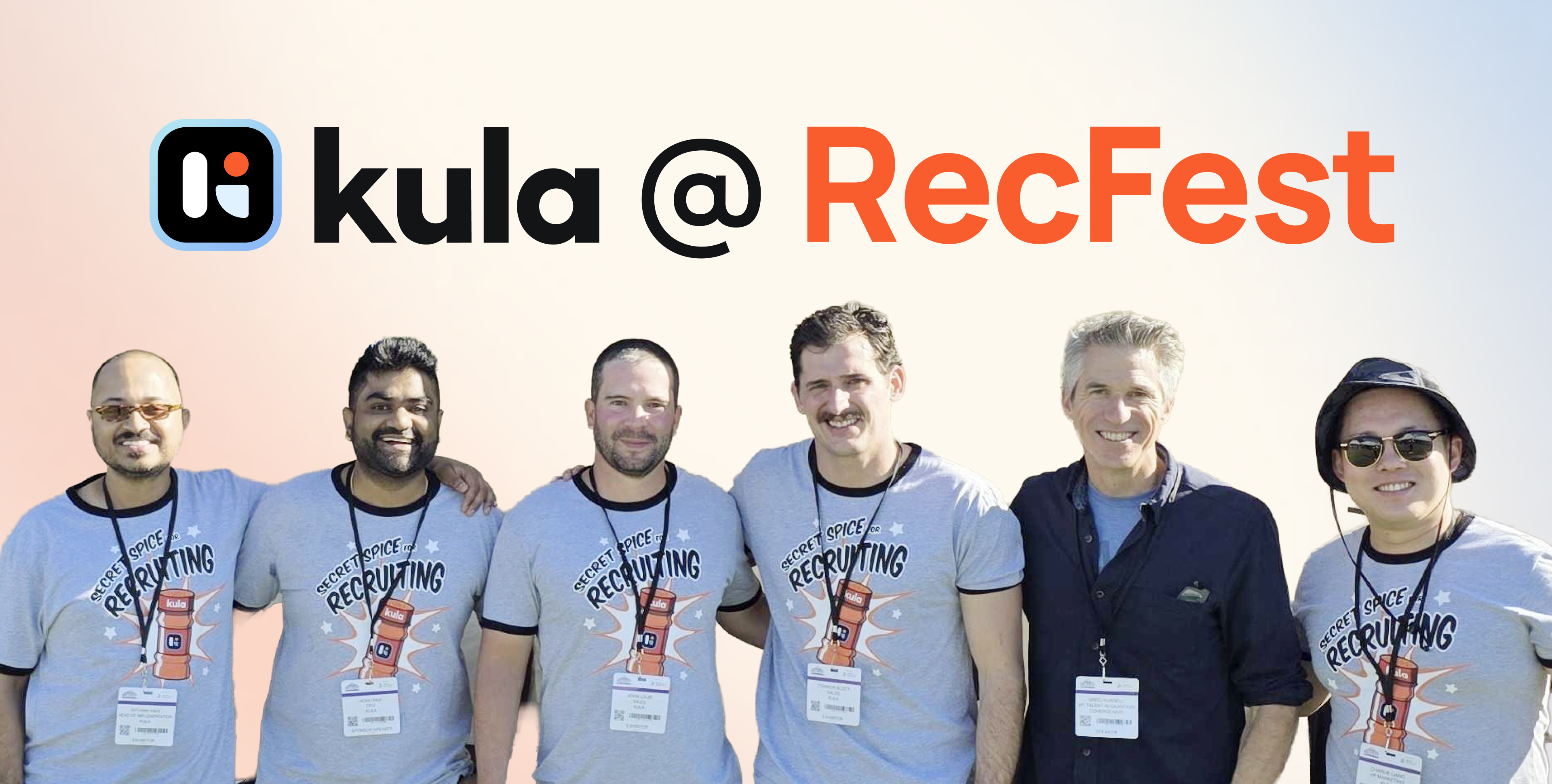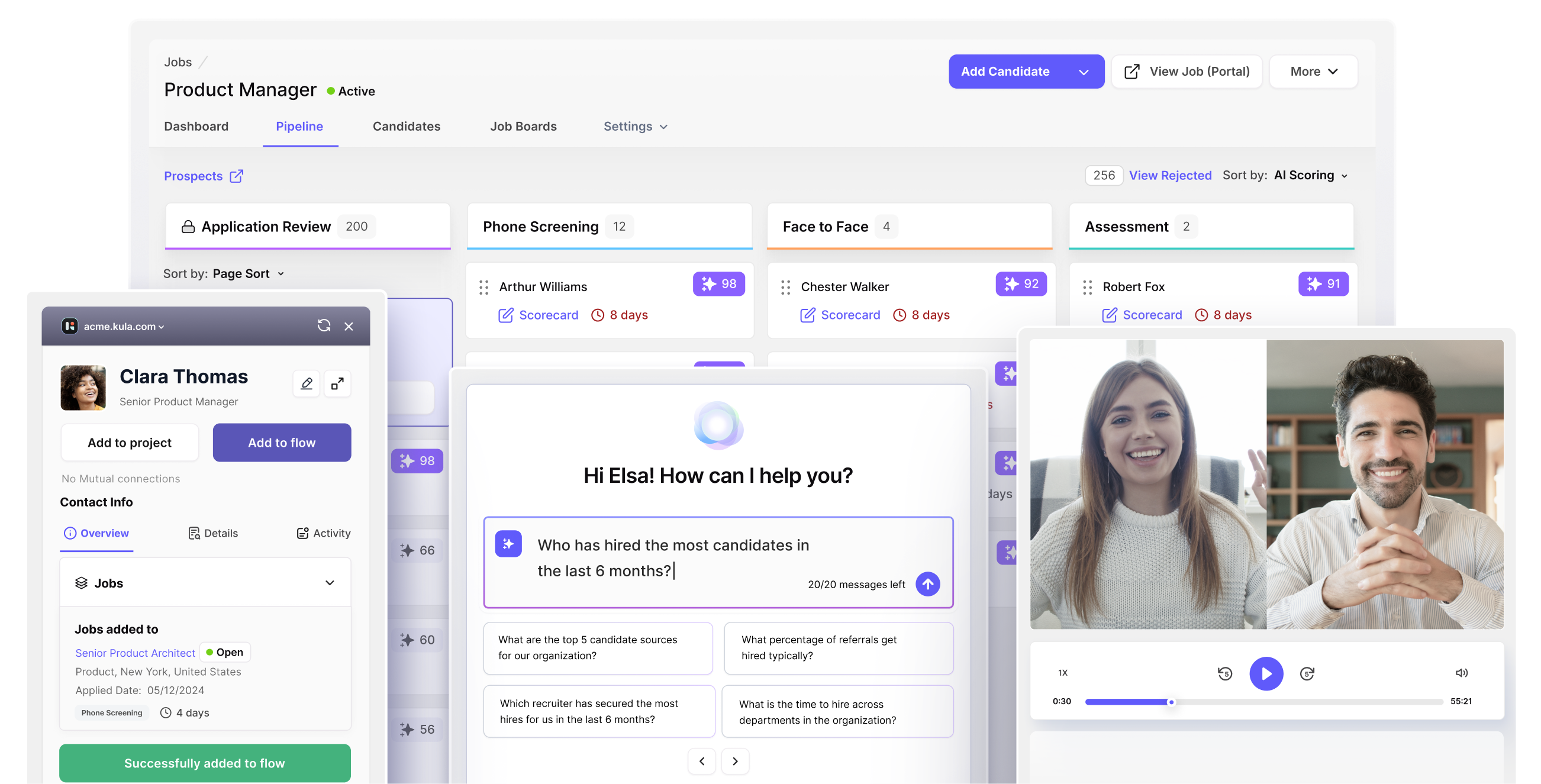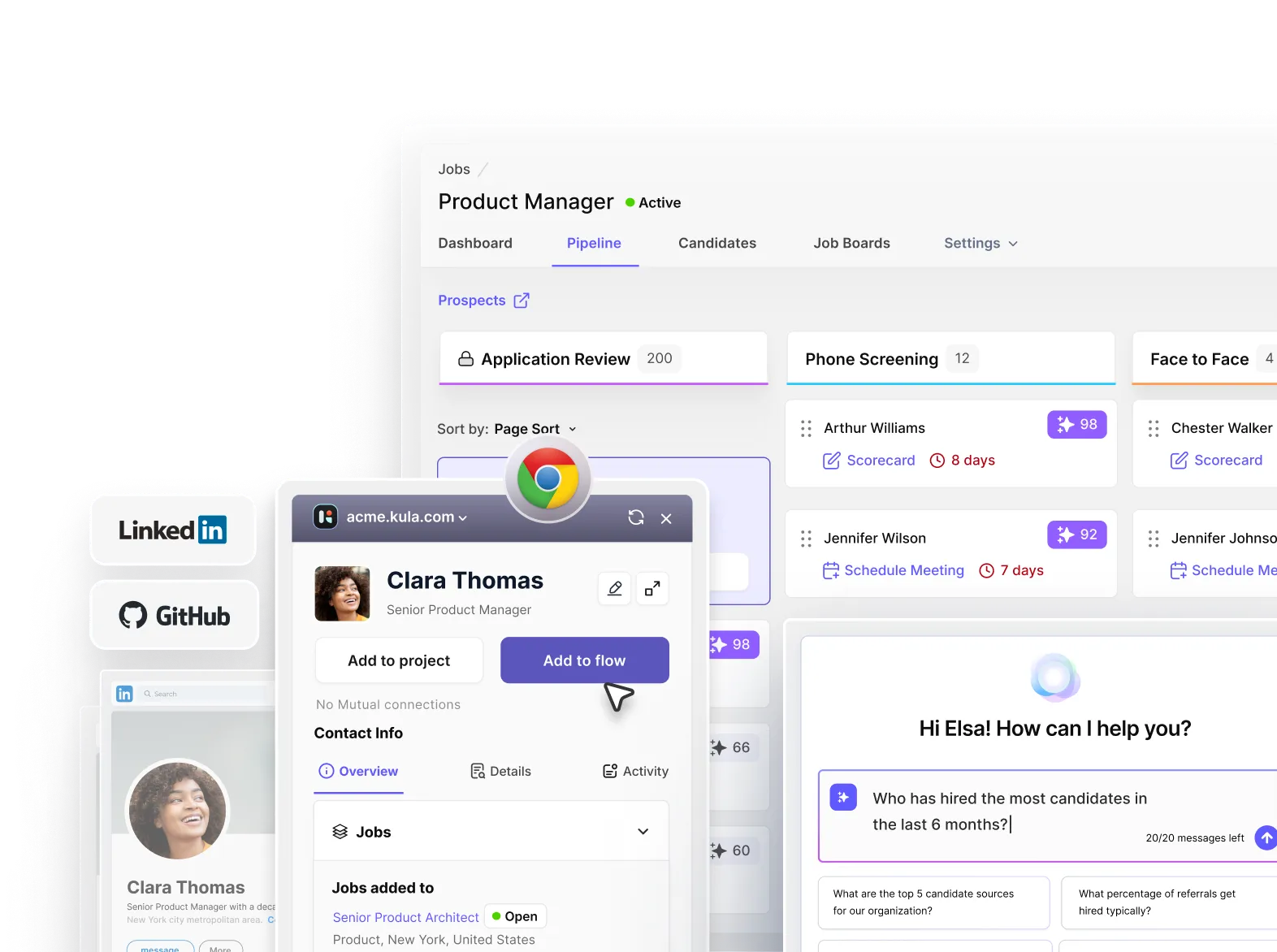Book a 30-minute demo and learn how Kula can help you hire faster and smarter with AI and automation
Recruiting KPIs allow organizations to make smarter and data-driven hiring decisions. However, you can not pick any random recruiting KPI and expect wonders in your hiring.
To see real impact, companies must first be strategic in choosing the right KPIs.
So, how do you select the most relevant KPIs for your company? How do you ensure they align with your business and recruiting objectives? And most importantly, how do you track them to drive meaningful progress?
Learn everything in this guide.
Why is it important to align recruiting KPIs to business outcomes?
Aligning recruiting KPIs to business objectives is important because of:
1. Improved hiring quality
When you select and track the right recruitment key performance indicators that are aligned with business outcomes, you focus on hiring candidates who truly fit the company’s needs.
Instead of tracking vanity metrics like the number of applications filed or interviews taken, you prioritize skills first assessment and fair assessment for quality hire.
Ultimately, when your recruitment efforts align with business goals, every hire contributes to company growth rather than just increasing headcount.
2. Better resource allocation
Hiring takes time, money, and effort—but without the right KPIs, resources may be wasted on inefficient processes.
Tracking the right KPIs allows hiring managers to make data-driven changes in their recruiting strategy. For example, if data shows that employee referrals give your organization the best long-term hires, you can shift resources toward referral programs instead of low-performing job boards.
3. Faster time-to-impact
Well-aligned recruiting metrics ensure new hires are productive and contribute to business goals sooner.
This helps make your training and onboarding program more efficient so that it takes less time for your employees to start contributing at a satisfactory level.
4. Stronger business partnership
Hiring isn’t just an HR function—it should be a strategic partnership between talent acquisition and leadership.
When hiring supports long-term goals, recruitment becomes a key driver of company growth rather than just an administrative process.
An organization's recruiting process becomes more impactful when you include the goals aligning KPIs in your talent acquisition strategy.
5. Higher retention rates
Aligning recruiting KPIs with business outcomes ensures companies hire candidates who are not just a good skill fit but also align with company culture, values, and growth plans.
A strategic approach to recruitment also means investing in better onboarding, training, and career development, which increases job satisfaction. When employees feel valued and see growth opportunities, they stay longer, reducing hiring costs and improving overall workforce stability.
How to align recruiting KPIs to business outcomes?
Here is a step-by-step guide on aligning recruiting KPIs to business objectives in 2025:
1. Analyze the business and recruitment goals and objectives

You can not know the right KPIs and best recruiting strategy without evaluating your business and recruitment goals. Your evaluation must not be limited to the recruiting team and HR.
The following key stakeholders must be involved in the recruiting process:
- Business leadership (CEO, COO, Founders)—for defining vision, growth, expansion, innovation, cost reduction
- HR & talent acquisition team—for assessing the current hiring situation
- Hiring managers & department heads—for providing input on required skills, cultural fit, and new hires’ performance post-recruitment.
- Finance team—to allocate budget, and track cost-per-hire and return on investment
- Employees & new hires—to collect feedback on the hiring process, and refine candidate experience and employer branding
A clear understanding of the company’s overall vision—whether it’s scaling rapidly, improving operational efficiency, or entering new markets—sets the foundation for a targeted hiring approach.
For example, suppose your company's goal is to boost diversity and inclusion. In that case, you will focus on diversity and inclusion KPI more and will work on attracting talent from diverse backgrounds without hiring unbiased.
Learn about all the important recruiting goals from here.
This clarity also helps hiring managers include key stakeholders in hiring decisions.
This doesn’t have to take much time, as Kula helps you design automated workflows to include whoever you want in your recruiting process.

It also allows you to add a scorecard to the workflow, enabling you to ask customized questions to assess the quality of the hire and gather feedback.

💡Quick summary:
You must evaluate business and recruiting goals by involving key stakeholders like leadership, HR, hiring managers, finance, and employees.
2. Assessing recruiting performance: identifying strengths and weaknesses in your workforce
To fix the gaps, hiring managers need to know what your recruiting team's strengths and weaknesses are.

For example, take note of recruiting challenges like:
- If you’re taking weeks to hire?
- If you’re team is drowned in spreadsheets while decision-making?
- If you’re new hires frequently leave within the first six months?
Evaluating such recruiting challenges will allow you to focus on important recruiting KPIs that will immediately impact your hiring results.
Read more about these recruitment challenges and how you can remove them.
Also, about the strengths, you want to analyze them too to refine them and get more impact.
For example, if you’re team is already delivering a standout individual candidate experience, this is a strength worth building upon.
You can work towards facilitating mass candidate engagement and delivering constructive personalized feedback at scale with AI.
Kula simplifies this process.
With Kula, you can create a structured workflow for any job, scheduling automated communication across platforms like LinkedIn and email for different stages.

Hiring managers can also add as many candidates as needed.
Also, use Kula’s AI-powered message generator for outreach to save time.

So, you will be performing proactive communication with your candidates at scale in a one-time setting.
💡Quick summary:
Identify weak spots in your hiring process to target the right recruiting KPIs for success. Also, assess your strengths and performance levels to refine KPIs where further improvement can drive greater impact.
3. Customize your talent acquisition strategy
This is the step where you do most action.
Use all the data-driven insights to refine your approach, including:
Identifying the right KPIs for your recruiting team
Now you have all the data, ask yourself what outcomes matter most for your business—are you focusing on faster hires, better candidate quality, or reducing turnover?
For example, if your business values fast hiring, track time-to-fill KPI. If you’re focused on quality, measure quality-of-hire KPI.
Also, choosing the right KPIs becomes easy when you focus on
- Core KPIs that remain essential throughout industries (such as time to hire, or source of hire)
- Specific KPIs important for your business (such as time-to-productivity)
- Long-term and border recruiting experience KPIs (candidate satisfaction or diversity hiring)
- Short-term KPIs to achieve quick results (such as cost per hire and time to fill)
Setting realistic targets for each KPI
Now you have a list of important recruiting KPIs to monitor, here’s an example of (time-to-fill KPI) how to approach it:
Step 1: Understand the historical data of this KPI to get your baseline. Let’s say it currently takes an average of 45 days to fill a role.
Step 2: Set a realistic target, and consider factors such as hiring volume, industry standards, and internal processes. Let’s say, a 10% improvement makes sense.
Step 3: Now, break down the target in the short term (reduce time-to-fill by 5% within 3 months) and long-term goals (achieve 40 days within 6 months).
Step 4: Track weekly or monthly progress with AI-powered recruiting analytics.
💡Quick summary:
Identify the right key KPIs by focusing on core, specific, short-term, and long-term recruiting goals. Also, set realistic targets for each of these KPIs that seem to be achievable and track monthly progress.
4. Use the ATS tool for effective goal alignment

Manually executing and tracking hiring strategy is an outdated concept that can easily cost your company extra money and top candidates.
ATS tools help companies automate candidate sourcing and tracking. They also improve candidate assessment and collaboration among hiring teams, making recruitment more efficient.
If your organization is still not using an ATS, learn the answers to 60 common questions about applicant tracking systems that your company may have. This includes answers on interview management, candidate offers, integrations, implementations, and other key aspects.
Talking about your best option, we at Kula do a pretty good job!

We are an AI-powered ATS tool, so you’re hiring teams can focus on core functions and leave hiring work to us.

Unlike many other ATS tools that work more like an HR project management tool. Kula helps recruiters smoothly navigate the hiring process with AI-powered interview tools, easy-to-use workflow builders, and AI candidate scoring.
With Kula, you can easily:
- Create visual workflows for every recruiting process
- Use AI- interview features for automated notetaking and summaries
- Focus on the top 5% of qualified candidates with AI-scoring
- Create a career site in just a few clicks—without any coding knowledge
- Perform talent pipeline management and passive candidate sourcing
- And of course, the advanced AI analytics we just talked about
The tool also integrates easily with your existing tech stack and all the other recruitment solutions you use and helps you manage all your activities on a single platform.

Looking for an all-in-one ATS tool for your business? Schedule a demo now to see Kula AI’s in action!
💡Quick summary:
Use an ATS tool for a faster, more efficient recruiting process. Kula stands out with automation, easy setup, and AI-powered features for job applications, career sites, and interviews.
5. Review and revise KPIs continuously
Companies must establish a standard policy for reviewing and revising recruiting KPIs. These revisions should focus on:
- Evaluating the efficiency of the current hiring strategy
- Tracking progress toward set targets
- Aligning KPIs with evolving goals, market conditions, and hiring needs
If certain KPIs fail to provide actionable insights, it is important to take immediate action to ensure they contribute to business success.
Companies must also not neglect stakeholders’ feedback. Their feedbacks help recruiters understand how efficiently new hires contribute to team performance and productivity.
These revisions must be done at least quarterly, though monthly or annual reviews may be suitable for some organizations, depending on business needs.
With Kula, you can automatically generate customized reports of all the recruiting KPIs that matter most to you.
Kula Analytics' standout feature is its Conversational AI. It works like a chatbot and helps you get insights quickly into your KPIs and other hiring aspects.

💡Quick summary:
Review and revise recruiting KPIs monthly, quarterly, or annually, based on your business needs. Also, involve stakeholder feedback to understand the on-ground impact of your hiring strategy.
Bonus Point
6. Set up strong communication throughout the process
Companies need to set up clear and strong communication policies across the departments for hiring managers to create an effective recruitment process.
The recruitment team must not work isolated as it will always give an unclear view of their recruiting efforts.
Right from the evaluation of the goals to post-hire performance metrics, hiring teams must collaborate with different department heads and business leaders to align their strategies with companies vision.
This cross-functional accessibility helps optimize recruitment strategies by providing the hiring team with a collective, data-driven perspective. High-quality candidates will also recognize and appreciate a well-structured, transparent hiring process.
Such integrated communication throughout the recruitment funnel also automatically impacts many important KPIs such as candidate experience, hiring manager satisfaction, quality of hire, cost per hire, and others.
Common pitfalls in implementing recruiting KPIs and how to avoid them
Learn how to tackle common challenges for better alignment of recruiting KPIs:
1. Overemphasizing speed over quality
In the pursuit of rushing the hiring process, recruiters tend to perform poor assessment of candidates which leads to high turnover, increased training costs, and lost productivity.
However, nowadays, recruiters can not afford to take things slow be it because of the growing needs of companies or fear of losing top candidates to competition.
Kula with its AI capabilities allows recruiters to speed up the hiring process while not losing efficiency.
With Kula, recruiters can perform automated hiring workflows, candidate sourcing, candidate scoring, fair assessment, and talent pipeline management.

Kula is also an AI-powered ATS tool, so it helps you speed up the application and career site creation, and allows you to access and advanced recruitment analytics.

Kula’s AI-powered interview intelligence feature also helps you assess candidates faster with automated summaries and scoring.
All this helps you speed up your hiring process without losing top talent and overspending.
2. Ignoring post-hire performance metrics
Many organizations fail to track post-hire performance metrics such as productivity, retention, and cultural fit. This leads to an incomplete assessment of whether your recruitment efforts are truly effective or not.
To avoid this, companies must establish a feedback loop between HR and department heads to assess new hires’ effectiveness.
Also, linking hiring KPIs to post-hire data helps identify patterns—such as which recruitment channels bring the best talent—allowing businesses to improve their hiring processes.
3. Not leveraging employee feedback for recruitment insights
Employee feedback is a goldmine for refining recruitment strategies, yet many companies overlook it.
Candidates experience the hiring process differently than recruiters, and employees know first-hand whether new hires fit well into the team.
Current and past employees can offer insights into what worked, what didn’t, and where the hiring process can improve.
Gather feedback through surveys, exit interviews, or casual check-ins to understand candidate experience, onboarding effectiveness, and cultural alignment. Their input helps identify gaps in job expectations, hiring accuracy, and retention challenges.
4. Do not neglect the power of employer branding
Many companies tend to adopt tunnel vision for specific KPIs that in an easy picture seem to directly impact the recruiting process.
However, employer branding is that very essential KPI that directly impacts the quality of the hire as a well-established employer brand automatically attracts candidates who align with company values, leading to better cultural fit and retention.
Companies with a strong employer brand also spend lower recruiting costs than others because high-quality candidates are naturally drawn to them.
Design brand-aligned career sites with Kula and boost your recruitment performance. Schedule a demo now, and see the impact on your next hire!






















